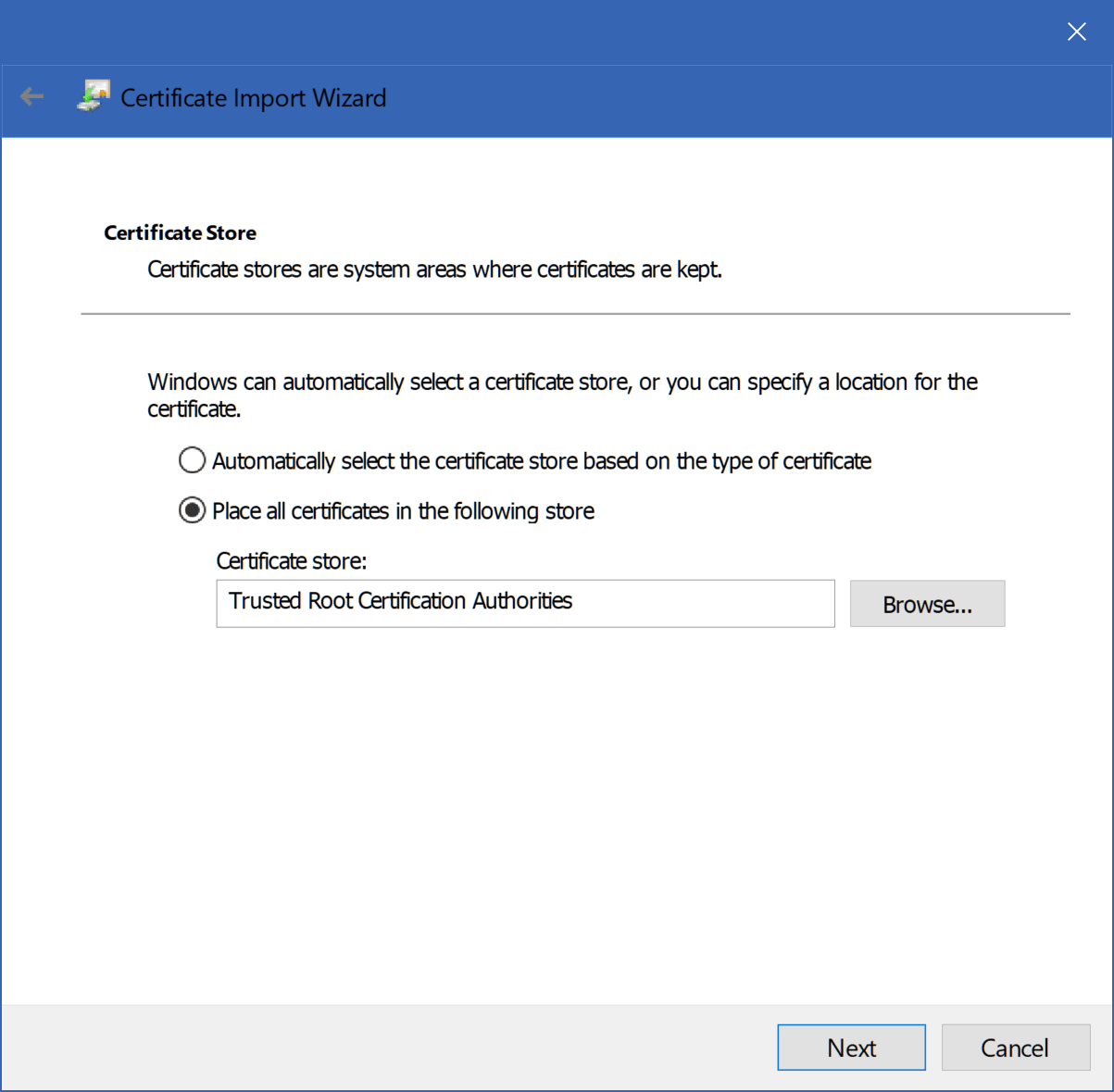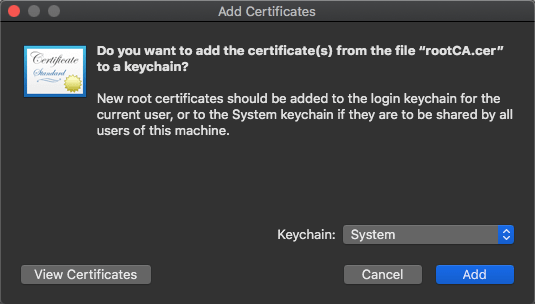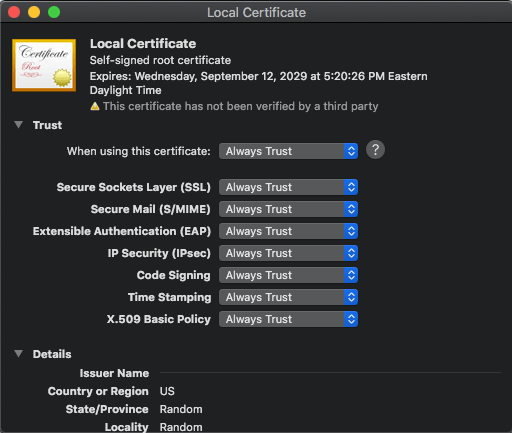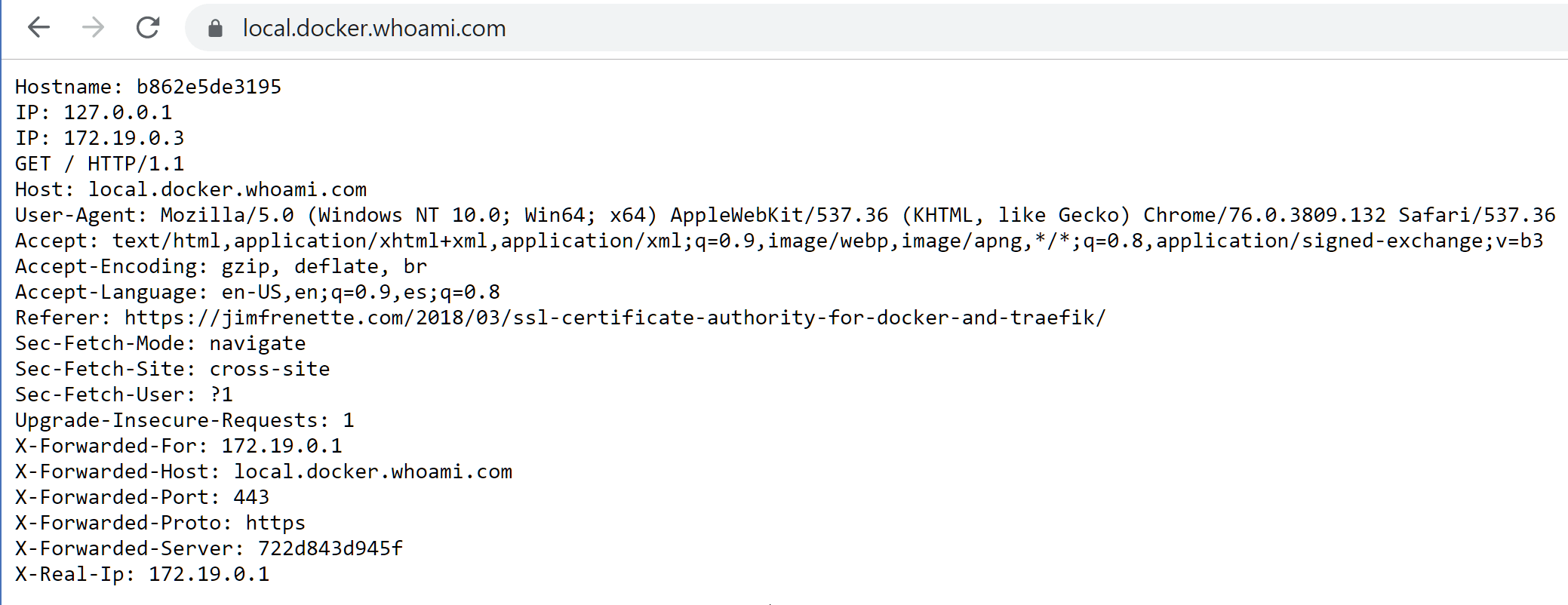SSL Certificate Authority for Docker and Traefik
This post documents how to get https working on your local Docker development environment using Traefik as a reverse proxy for multiple services.
Step 1 - Root SSL Certificate
Create a sub directory to store generated keys, certificates and related files in your home folder, for example .ssl.
Using OpenSSL, generate the private key file, rootCA.key.
For Windows, use Cygwin, Git Bash, PowerShell or other Unix-like CLI.
mkdir .ssl
cd .ssl
openssl genrsa -des3 -out rootCA.key 2048
This root certificate can be used to sign any number of certificates you may need to generate for individual domains.
Using the key, create a new root SSL certificate file named rootCA.cer. This certificate will be valid for 10 years (3650 days).
openssl req -x509 -new -nodes -key rootCA.key -sha256 -days 3650 -out rootCA.cer
Country Name (2 letter code) [AU]:US
State or Province Name (full name) [Some-State]:Random
Locality Name (eg, city) []:Random
Organization Name (eg, company) [Internet Widgits Pty Ltd]:Random
Organizational Unit Name (eg, section) []:Random
Common Name (e.g. server FQDN or YOUR name) []:Local Certificate
Email Address []:example@domain.com
If you need a
.pemfile, simply copy and rename the generated certificate file. For example,cp rootCA.key rootCA.pem
Import The Root Certificate
The host system needs to have the root certificate imported and set as trusted so all individual certificates issued by it are also trusted.
Windows
Run Win + R and enter mmc to open the Microsoft Management Console.
Then select File, Add/Remove Snap-ins.
Select Certificates from the available snap-ins and press the Add button.
From the Certificates Snap-in dialog, select Computer account > Local Computer (the computer this console is running on), and press the Finish button to close the window.
Then press the OK button in the Add or Remove Snap-in window.
Select Certificates (Local Computer) and right-click Trusted Root Certification Authorities > All Tasks > Import to open the Certificate Import Wizard dialog. Browse for the rootCA.cer digital certificate file. e.g., ~/.ssl/rootCA.cer.
Select Next to place the certificate in The Trusted Root Certification Authorities store.

Then select Finish to close the dialog.
OS X
Double-click the rootCA.cer to open it in Keychain Access.
The rootCA.cer certificate appears in the Login Keychain.
Change the Keychain dropdown to System.

Unlock the System Keychain, Open the Local Certificate, expand Trust
Change the When using this certificate: dropdown to Always Trust.

Step 2 - Domain SSL Certificate
Create a sub directory in the .ssl folder for the local.docker.whoami.com domain certificate.
cd .ssl
mkdir local.docker.whoami.com
These steps are performed in the local.docker.whoami.com folder.
cd local.docker.whoami.com
Create an OpenSSL configuration file named server.csr.cnf.
server.csr.cnf
[req]
default_bits = 2048
prompt = no
default_md = sha256
distinguished_name = dn
[dn]
C=US
ST=RandomState
L=RandomCity
O=RandomOrganization
OU=RandomOrganizationUnit
emailAddress=noreply@local.docker.whoami.com
CN = local.docker.whoami.com
Create a v3.ext file for the X509 v3 certificate.
v3.ext
authorityKeyIdentifier=keyid,issuer
basicConstraints=CA:FALSE
keyUsage = digitalSignature, nonRepudiation, keyEncipherment, dataEncipherment
subjectAltName = @alt_names
[alt_names]
DNS.1 = local.docker.whoami.com
Create a certificate key named server.key for the local.docker.whoami.com domain using the configuration settings stored in the server.csr.cnf.
openssl req -new -sha256 -nodes -out server.csr -newkey rsa:2048 -keyout server.key -config <( cat server.csr.cnf )

Certificate signing request is issued using the root SSL certificate to create a local.docker.whoami.com domain certificate. The output is a server.crt certificate file.
openssl x509 -req -in server.csr -CA ../rootCA.cer -CAkey ../rootCA.key -CAcreateserial -out server.crt -days 730 -sha256 -extfile v3.ext

Browser - Root Certificate Import
Import the root CA certificate into the web browser trusted root certificate store.
Chrome: Settings (chrome://settings/) > Privacy and security, Manage certificates > Import, follow prompts to Browse for .ssl/rootCA.cer. In The Import Wizard Dialog | Certificate Store, Choose Automatically select the certificate store based on the type of certificate.
Firefox: Options > Privacy & Security, Certificates | View Certificates, Authorities > Import. Browse for the .ssl/rootCA.cer and select all 3 Trust checkboxes.
Traefik
Create a traefik project folder with a certs sub directory.
mkdir -p ~/traefik/certs
Copy the domain certificate and key in the local.docker.whoami.com folder into the traefik/certs folder and rename them to match the respective domain. For example,
cd local.docker.whoami.com
cp server.crt ~/traefik/certs/local.docker.whoami.com.crt
cp server.key ~/traefik/certs/local.docker.whoami.com.key
In the traefik project folder, create this traefik.toml file.
traefik.toml
defaultEntryPoints = ["http", "https"]
[entryPoints]
[entryPoints.http]
address = ":80"
[entryPoints.https]
address = ":443"
[entryPoints.https.tls]
[[entryPoints.https.tls.certificates]]
certFile = "/etc/traefik/certs/local.docker.whoami.com.crt"
keyFile = "/etc/traefik/certs/local.docker.whoami.com.key"
In in the traefik project folder, create this docker-compose.yml file to configure Traefik services and networks.
docker-compose.yml
version: "3"
services:
proxy:
image: traefik:v1.7
restart: unless-stopped
command: --docker --logLevel=DEBUG
ports:
- "80:80"
- "443:443"
volumes:
- /var/run/docker.sock:/var/run/docker.sock
- ./certs:/etc/traefik/certs
- ./traefik.toml:/etc/traefik/traefik.toml
networks:
default:
external:
name: webgateway
update: note that we’re pulling a traefik version 1 image in the docker-compose.yml above. The traefik:latest image switched to version 2 in September 2019. A configuration migration guide can be found here should you want to use version 2.
Create this docker-compose.yml file in the whoami project folder.
docker-compose.yml
version: "3"
services:
app:
image: emilevauge/whoami
networks:
- web
labels:
- "traefik.backend=whoami"
- "traefik.frontend.rule=Host:local.docker.whoami.com"
networks:
web:
external:
name: webgateway
Hosts
Add 127.0.0.1 local.docker.whoami.com to your computers hosts file
Docker
Create a network named webgateway.
docker network create webgateway
Bring up the traefik container followed by the whoami container using docker-compose. For example,
cd ~/traefik
docker-compose up -d
cd ~/whoami
docker-compose up -d
Navigate to https://local.docker.whoami.com in a browser that has imported the root CA certificate into its trusted root store.

